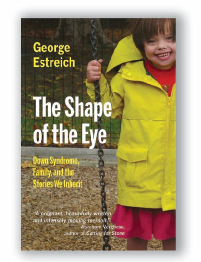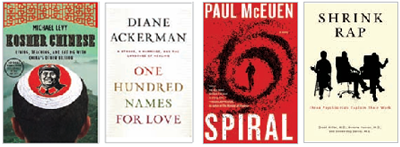The Shape of the Eye by George Estreich, MFA '89 (Southern Methodist)
The Shape of the Eye by George Estreich, MFA '89 (Southern Methodist)

Estreich's memoir tells the story of his younger daughter, Laura, born with Down syndrome, and delves into the science of genetics, family history, and the career of John Langdon Down, the nineteenth-century physician who described the patients who would later bear his name. As Estreich writes, "Laura's chromosome count taught me that every child is a genetic risk; years later, remembering an infant I did not know, I learn—again—that it is not only the chromosome, but our response to it, that shapes the contour of a life."

Kosher Chinese by Michael Levy '98 (Holt). During Levy's Peace Corps tour as an English teacher in the city of Guiyang in central China, far from the economic powerhouses of the country's coastal cities, he became the reluctant host of the Guizhou University Jewish Friday Night English and Cooking Corner Club, was drafted onto the local basketball team, befriended members of the Bouyei minority, witnessed his students' struggles with the ins and outs of Chinese-style capitalism, and saw how the "other billion" lives. While trying to avoid cultural faux pas, he also learned to eat "anything with four legs but the table."
One Hundred Names for Love by Diane Ackerman, PhD '79 (Norton). When Ackerman's husband, the novelist Paul West, suffered a stroke in 2005, it was tailor-made to be a writer's private hell: he was diagnosed with global aphasia, and the monosyllable "mem" was the only thing he could say. Ackerman swamped her husband with language and insisted that he talk. Against the odds, West recovered his ability to speak and write. Even though his writing has changed, the flavor of his imagining remains the same. "A bell with a crack in it may not ring as clearly," she writes, "but it can ring as sweetly."
Spiral by Paul McEuen (Dial). Heeding the advice to write what you know, McEuen— professor of physics and director of the Kavli Institute at Cornell for Nanoscale Science—makes his hero, Jake Sterling, a Cornell nanoscientist, and employs the University and Ithaca as the setting of his debut thriller. When the apparent suicide of an emeritus professor of biology in Fall Creek gorge turns out to be murder, Sterling must draw upon his knowledge of nanotechnology to uncover the killer and stop a plot to release a World War II-era bioweapon.
Shrink Rap by Dinah Miller, MD '88, Annette Hanson, and Steven Roy Daviss (Johns Hopkins). While the psychoanalyst's couch may be the general public's image of psychiatry, psychoanalysis is a small subspecialty of the discipline. "Psychiatry can be seen as a mysterious and covert medical specialty," write the psychiatrists who run the podcast series "My Three Shrinks" and the "Shrink Rap" blog. "Many would replace the image of the couch with an image of a brain, though neither fully captures what our field is all about." The writers aim to demystify psychiatry and describe their field in plain English.
Fiction
The Metropolis Case by Matthew Gallaway '90 (Crown). Using his characters' obsession with Wagner's Tristan and Isolde as his focus, Gallaway weaves together the stories of three opera singers and a music-loving lawyer in a debut novel that moves from the opera capitals of Europe to New York City, and from the nineteenth to the twentieth century.
This Beautiful Life by Helen Schulman '83 (HarperCollins). After the Bergamot family moves from Ithaca to New York City's Upper West Side, their comfortable new life is turned upside down when their teenage son forwards a sexually explicit video that goes viral on the Internet.
Non-Fiction
An Englishwoman in California edited by Zoë Klippert '64 (Bodleian Library). Catherine Hubback, Jane Austen's niece and a novelist in her own right, emigrated from England to Oakland, California, in 1871. Her letters home give a portrait of a turbulent time in U.S. history. Klippert edits the letters and provides an informative background to Hubback's life.
A Physician Under the Nazis edited by David Glenwick '71 (Hamilton). A professor of psychology at Fordham University edits his father's memoirs, written when he was a Jewish physician during World War II in the Ukraine, the Warsaw ghetto, and concentration camps, and chronicling the start of his new life in America.
Rising Force by James D. Livingston '51 (Harvard). A former GE physicist and lecturer at MIT explores the concept of magnetic levitation—"maglev"—and describes the science behind electromagnetic forces, superconductors, force fields, and the development of maglev trains that can travel as fast as 270 miles per hour.
Prison Blossoms edited by Miriam Brody, PhD '88, and Bonnie Buettner, PhD '84 (Harvard). A professor of German studies and her colleague edit the 1890s-era prison writings of the anarchists and labor organizers Alexander Berkman, Henry Bauer, and Carl Nord, which were smuggled out to Emma Goldman and others in the movement.
The Quest for the Cure by Brent R. Stock-well '94 (Columbia). Exploring the history of drug research to combat Alzheimer's, cancer, and other diseases, an associate professor of biology and chemistry at Columbia describes the complex path to medical breakthroughs.


